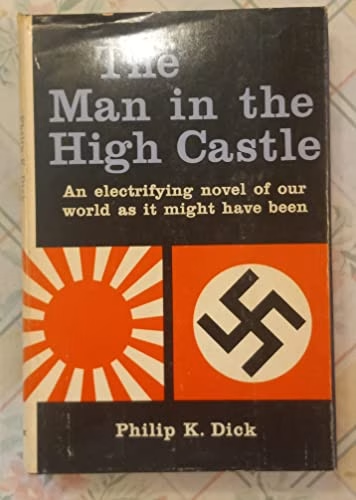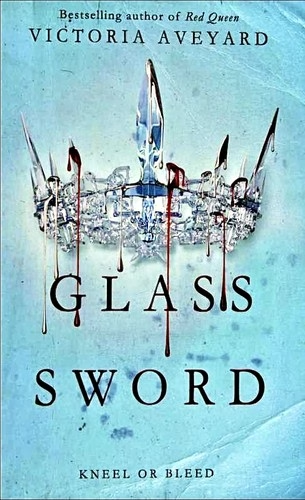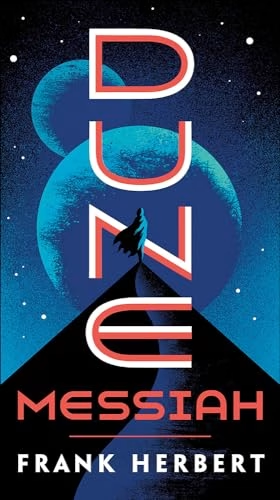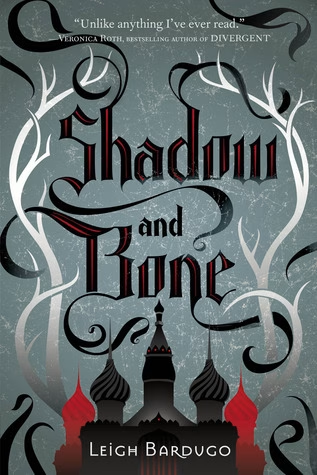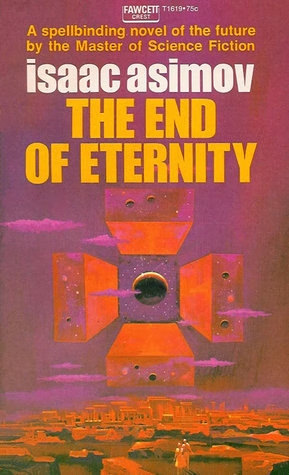Plot Summary:
An Axis Victory and a Divided America
Fifteen years after the Axis powers won World War II, the world is carved between the triumphant victors. The German Reich controls Europe, Africa, and the eastern United States. The Japanese Empire controls Asia and the Pacific States of America (PSA), the former U.S. West Coast. A neutral buffer zone, the Rocky Mountain States, lies between them. In this oppressive new world, the lives of several individuals begin to intersect around objects of questionable authenticity and a subversive book.
In Japanese-controlled San Francisco, Robert Childan, the anxious proprietor of American Artistic Handcrafts, Inc., caters to the Japanese elite’s obsession with pre-war American artifacts. He struggles to maintain his “place” in the rigid social hierarchy. Frank Frink, a secretly Jewish war veteran, is fired from the W-M Corporation, a metalworking factory that secretly forges the very Americana antiques that Childan sells. Humiliated and desperate, Frink decides to start a custom jewelry business with his co-worker, Ed McCarthy, creating original, contemporary American art.
Meanwhile, Nobusuke Tagomi, a high-ranking official at the Japanese Trade Mission, awaits the arrival of a Swedish industrialist named Baynes. A devout follower of the I Ching (the Chinese Book of Changes), Tagomi senses that this meeting holds more significance than a simple business deal. In the Rocky Mountain States, Frank’s estranged wife, Juliana Frink, works as a judo instructor. Restless and searching, she meets Joe Cinnadella, a brooding Italian truck driver and war veteran, and is drawn into an intense and unsettling affair with him.
A common thread in their lives is a banned but widely circulated novel, The Grasshopper Lies Heavy, by Hawthorne Abendsen. The book imagines an alternate history in which the Allies won World War II, a concept that offers a glimmer of hope to the conquered and is a source of fascination for the conquerors.
Schemes and Revelations
Frank Frink, seeking revenge on his former boss, Wyndam-Matson, masterminds a scheme. Disguised as a representative for a fictional Japanese admiral, he visits Childan’s shop and exposes a valuable Colt .44 revolver as a forgery. The incident shatters Childan’s confidence and sends ripples through the lucrative fake-antiques market. Using the threat of exposure, Frink and McCarthy successfully blackmail Wyndam-Matson for the capital to start their jewelry business, Edfrank Custom Jewelry.
The world is thrown into turmoil with the sudden death of the German Chancellor, Martin Bormann. This event delays the crucial meeting between Mr. Baynes—who reveals himself to be Captain Rudolf Wegener, an agent for the German Abwehr (military intelligence)—and his Japanese contacts. Wegener has come to San Francisco to warn a high-level Japanese official about a secret Nazi plan, Operation Dandelion: a surprise, unprovoked nuclear attack on the Japanese Home Islands, orchestrated by a faction within the Nazi party.
Juliana and Joe Cinnadella begin a road trip, with Joe revealing a fanatical devotion to Nazi ideology and an obsession with The Grasshopper Lies Heavy. He persuades a reluctant Juliana to travel with him to Cheyenne, Wyoming, to meet the author, Hawthorne Abendsen, who is rumored to live in a fortified compound known as the “High Castle.”
Childan, his business threatened by the revelation of forgeries, struggles to sell the new, original jewelry made by Frink and McCarthy. He shows a unique silver pin to a sophisticated young Japanese client, Paul Kasoura. Paul is initially dismissive but later comes to believe the piece possesses a profound spiritual quality he calls wu—an authenticity derived from its creation, not its history. However, this insight leads to a humiliating proposal: a powerful importer suggests mass-producing the designs as cheap, magical trinkets for the “uneducated masses.” Childan, feeling his culture is being mocked, experiences a moment of profound crisis and defiance. In a heated confrontation with Paul, he rejects the plan, defending the jewelry’s intrinsic artistic worth. This unexpected act of cultural pride earns him Paul Kasoura’s deep respect, and a true connection is forged.
Violence and Moral Crossroads
The political chaos in Germany intensifies. Wegener finally arranges his meeting with Mr. Tagomi and his true contact, the revered and supposedly retired General Tedeki of the Imperial Army. Wegener reveals that the new Chancellor, Joseph Goebbels, is a proponent of Operation Dandelion. Paradoxically, the only major figure powerful enough to stop him is his rival, the sinister SS chief Reinhard Heydrich. Wegener’s desperate mission is to persuade Japan to subtly support the monstrous Heydrich to avert nuclear annihilation.
The meeting is violently interrupted. Two assassins from the German SD (the Nazi security service) storm Tagomi’s office to kill Wegener. In a moment of shocking violence, the pacifist Mr. Tagomi, using a historic Colt .44 from his collection, shoots and kills both men. The act saves Wegener’s life but plunges Tagomi into a deep spiritual and psychological crisis.
In a hotel room in Denver, Juliana makes a terrifying discovery. Joe Cinnadella is not Italian; he is a German assassin, disguised and sent by the Nazis to find and murder Hawthorne Abendsen. The new clothes, the dyed hair, and the trip to Cheyenne are all part of his mission, and he needs her to act as bait. In a tense confrontation, Juliana uses a razor blade to defend herself, slashing Joe’s throat and leaving him to bleed to death.
Meanwhile, Frank Frink is arrested by the San Francisco police. They have discovered he is Jewish and plan to extradite him to the Reich, which means certain death in an extermination camp.
Inner Truth and Alternate Worlds
Haunted by the violence he has committed, Mr. Tagomi wanders the streets of San Francisco in a daze. Meditating on the Edfrank silver pin, he experiences a sudden, disorienting vision: he slips into another reality, a 1962 San Francisco that is recognizable to the reader but utterly alien to him, a world where whites are not subservient and the Axis never won. The experience is terrifying but ultimately transformative. Returning to his office, still shaken, he is presented with Frank Frink’s extradition papers. In a decisive act of moral courage, he refuses to sign them, writing “Release” on the form and saving Frank’s life. Immediately after, he collapses from a heart attack.
Frank Frink is released from custody with no explanation, unaware of his near-fatal brush with the Nazi death machine or of Tagomi’s intervention. He returns to his workshop, recommitting himself to the tangible act of creation.
Guided by the I Ching, Juliana travels to Cheyenne to warn Abendsen. She finds him not in a fortress but in an ordinary suburban home. She confronts him, demanding to know the truth behind The Grasshopper Lies Heavy. Abendsen confesses that he did not “write” the book in a conventional sense; he used the I Ching to make every plot decision, from the characters to the outcome. The oracle was the true author. Unsatisfied, Juliana asks the oracle directly: “Why did you write this book?” The coins form Hexagram 61, Chung Fu, or “Inner Truth.” The book is true. Germany and Japan did lose the war.
This revelation leaves Abendsen shaken, forced to confront a reality that even he cannot accept. But for Juliana, it is a moment of profound clarity. The oppressive world around her is somehow a shadow, a falsehood. With this knowledge, she leaves, her fear gone, contemplating a future where she might reunite with Frank.
Captain Wegener flies back to Germany, his mission complete but the future uncertain, knowing he will likely be arrested by one Nazi faction or another. The world remains balanced on a knife’s edge, but individual acts of creativity, courage, and the search for truth have opened a crack in the fabric of a false reality.
Characters
Robert Childan
An antiques dealer specializing in “Americana,” Childan is a man defined by his insecurity and his desperate attempts to find his “place” within the Japanese colonial hierarchy. He is initially obsequious, fawning over his Japanese clientele while harboring deep-seated racial resentment. His journey is one of finding authentic self-worth. When confronted with the truly original Edfrank jewelry, and the cynical proposal to mass-produce it as kitsch, he is forced to choose between profit and cultural integrity. His decision to stand up for the art’s intrinsic value is a pivotal act of rebellion, freeing him from his psychological subservience.
Frank Frink (Fink)
A skilled craftsman and secretly a Jew, Frank is a man trapped by fear. Having survived the war, he lives in constant anxiety under the Japanese, who might extradite him to the Nazis. His decision to create original art is an attempt to find meaning, but he is plagued by self-doubt. His arrest represents the culmination of his fears, but his inexplicable release, an act of grace he never understands, allows him to return to his craft, finding a quiet purpose not in understanding his fate, but in the simple, authentic act of creation.
Nobusuke Tagomi
A high-ranking official in the Japanese Trade Mission, Mr. Tagomi is the novel’s moral and spiritual center. He is a contemplative Buddhist who relies on the wisdom of the I Ching to navigate a world he finds increasingly chaotic. He is thrust from his world of bureaucratic decorum into one of brutal violence when he is forced to kill two assassins. This act shatters his worldview, leading to a profound spiritual crisis that culminates in a terrifying, momentary glimpse of our own reality. This experience ultimately leads him to his most significant act: a moment of pure conscience where he defies his duty and saves Frank Frink’s life.
Juliana Frink
Frank’s fiercely independent ex-wife, Juliana is a restless soul searching for meaning in the desolate landscape of the neutral Rocky Mountain States. Her journey is the most direct quest for truth in the novel. Drawn to the dangerous magnetism of Joe Cinnadella, she is forced to confront the brutal reality of the Nazi ideology firsthand. Her act of killing him is one of survival, but her subsequent decision to seek out Hawthorne Abendsen is a conscious choice to understand the meaning of it all. It is through her relentless questioning that the novel’s central mystery is revealed.
Mr. Baynes (Rudolf Wegener)
A captain in the Abwehr (German military intelligence), Wegener is a man of conscience operating within a monstrous system. He represents a dissident faction of “old-guard” Germans who find the nihilism of the ascendant Nazi ideology abhorrent. He risks his life to travel to the PSA to warn the Japanese of Operation Dandelion, forcing him into the paradoxical position of supporting the evil SS General Heydrich to prevent the greater evil of nuclear war. He is a pragmatic idealist, fully aware of the moral ambiguity of his world but committed to taking action.
Joe Cinnadella
Posing as an Italian war veteran, Joe is a fanatical Nazi assassin. He is a product of the regime: brutal, efficient, and devoid of empathy, hiding his violent purpose behind a mask of camaraderie. His mission to kill Hawthorne Abendsen represents the Reich’s desire to stamp out any truth that contradicts its own narrative. He is the embodiment of the soulless violence that underpins the Nazi world.
Hawthorne Abendsen
The author of The Grasshopper Lies Heavy is the enigmatic figure at the heart of the story’s mythology. Rumored to live in a fortress, he is in fact a man burdened by the truth his own work has revealed. He is not a visionary prophet but a channel for a higher power—the I Ching. He lives in a state of weary resignation, aware of the danger he is in but fatalistically accepting it. The truth he has helped create is one he cannot fully accept himself, showing the difficulty of confronting a reality that contradicts one’s own experience.
Core Themes
The Nature of Reality and Authenticity
This is the novel’s central question. Authenticity, or “historicity,” is a commodity in the trade of antiques, yet these antiques are often fakes. Frank Frink’s original jewelry possesses a spiritual authenticity, wu, that transcends its physical form, yet it is nearly turned into mass-produced kitsch. The most profound exploration of this theme is the novel-within-the-novel, The Grasshopper Lies Heavy. It presents an alternate “truth” that resonates so deeply with the characters that it challenges their own reality. Mr. Tagomi’s brief, terrifying vision of our world and the final revelation that The Grasshopper is “Inner Truth” from the oracle suggest that reality is not fixed but is a malleable, perhaps subjective, construct. The authentic is not what is old or historically verifiable, but what contains an inner, spiritual truth.
Moral Choice in a Corrupt World
The characters are constantly faced with impossible moral dilemmas in a world where good and evil are hopelessly entangled. Wegener must consider supporting the monstrous Heydrich to prevent a nuclear holocaust. Mr. Tagomi, a man of peace, must kill to save a life, an act that violates his core beliefs but is undeniably necessary. His ultimate act of redemption is a small, bureaucratic one with enormous consequences: he saves Frank Frink, a man he doesn’t know, by choosing human life over protocol. The novel argues that in a corrupt world, hope lies not in grand ideologies, but in these individual, often costly, acts of conscience.
Fascism, Dehumanization, and Hope
The novel offers a chilling portrait of life under totalitarianism. The Nazi regime is depicted as technologically advanced but spiritually barren, driven by abstract and hateful ideologies that devalue individual human life. Their grand projects—colonizing Mars, draining the Mediterranean—are contrasted with their casual genocide and internal savagery. The Japanese empire is more aesthetically refined but is still a system of colonial oppression. Hope in this bleak world emerges from small, unexpected places: the creative act of making something new and beautiful (Frink’s jewelry), the search for truth (Juliana’s quest), and individual acts of moral courage (Tagomi and Wegener).
Plot devices
The Book Within a Book (The Grasshopper Lies Heavy)
This metafictional device is the engine of the narrative. By placing an alternate history novel within his own alternate history, Dick creates a powerful tool for questioning the nature of reality. The Grasshopper is more than just a plot point; it is a subversive text that gives characters a language to imagine a different world. It acts as a symbol of hope, a catalyst for action (motivating both Juliana’s quest and Joe’s mission), and ultimately, the key to the novel’s deepest philosophical mystery.
The I Ching (Book of Changes)
The ancient Chinese oracle is a central and active force in the story. It is not merely a fortune-telling gimmick; it is treated by the characters as a source of profound wisdom and a guide for navigating their chaotic lives. Its pronouncements are often ambiguous but uncannily accurate. The ultimate revelation—that the I Ching itself “authored” The Grasshopper Lies Heavy—elevates it from a passive guide to an active, creative intelligence, a direct link to a transcendent truth that underlies the characters’ perceived reality.
Intersecting Storylines
The novel is told through the eyes of multiple protagonists whose paths cross in brief, often indirect, but highly consequential ways. Childan’s business is supplied by Frink’s former boss; Mr. Tagomi is Childan’s client and, unknowingly, Frank Frink’s savior; Juliana’s quest for the author of a book connects her to the deepest truths of her world. This fragmented structure mirrors the characters’ own feelings of confusion and alienation, while also reinforcing the theme that in a complex world, seemingly small and disconnected actions can have immense and unpredictable impacts.

